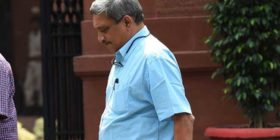It was midnight and the phone of senior Navy officer posted at the Naval Headquarters wouldn’t stop ringing. “The Australian has published a report claiming details of Project 75 (the official name for the submarine project) have been leaked,” the caller said.
Minutes later, after the report was read on phone, the Chief of Navy Staff Admiral Sunil Lanba was informed.
Defence Minister Manohar Parrikar, who was simultaneously informed by separate channels, immediately asked the Navy for a damage assessment and the possible place of the leak.
This morning Mr Parrikar told reporters “We knew about this last night”. But what he left unsaid was the flurry of activity that took place through the night.
Within an hour, all hands were at the deck at the South Delhi office from where Project 75 is monitored.
A section of officers were pouring over the original document of the Scorpene submarine and comparing them with the ones put out by The Australian. Others were tasked to check which officers had accessed the document and where the documents had moved to look for possible place of leak.
Simultaneously, the cyber experts of the Indian Navy – considered one of the best – stationed across the nation were on a dual job: Looking for traces of leak from computers in India and the cyber trail of the documents put out by the newspaper.
In Mumbai, a similar exercise was underway at the Mazagaon docks – the shipyard constructing the submarines.
The multiple checks ran through the night. In the morning, bleary-eyed officers were allowed to go home, shower and shave.
Within the hour, they were back at their desks.
The initial investigation report, short and factual, was placed before the Defence Minister – who was in his office by 10 am after attending a function despite being up till 4 in the morning.
A meeting of the Cabinet Committee on Security -the highest body in the country headed by the Prime Minister, which decides on security issues – was expected to take up the issue by afternoon.
As Mr Parrikar left for the CCS, he asked the Navy to issue the first official communication, which said documents had not leaked from India. The cyber experts who had worked through the night, told the ministry that the cyber trail of the leaked papers didn’t originate from India.
Soon after he returned from the CCS meeting, the Chief of Naval Staff again briefed Mr Parrikar. It was a longer briefing — on the possible fallouts of the leak.
The Navy’s conclusion did not change from the initial assessment it had given the Ministry.
Mr Parrikar was told that India had signed the deal with M/s Aramis and not DCNS. M/s Armaris was bought by DCNS subsequently. The leaked documents showed they were from DCNS. The minister was also told that the specifications in the leaked documents didn’t match.
“The basic shape, structure (of the submarines) like its height etc remains the same, but several modifications are made to suit our requirements. To put it in simple terms, the computer programme Windows has some basic similarities but Windows of 2007 and 2010 differ hugely,” a senior officer associated with the exercise told NDTV.
By late evening, Mr Parrikar and the Navy sat down again. The Navy reiterated that all checks pointed to an overseas leak and the damage, if any, was minimal. The Minister asked the Navy to shoot a query to the French manufacturer DCNS to ascertain the leak and come back to India.




Leave a reply